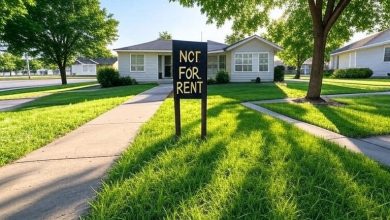The Ideal Length Of Time To Hold A Mortgage Until Paying It Off

Deciding whether to pay off a mortgage early—or how long to keep one—is ultimately a personal choice. In this post, I’ll share my perspective by drawing on both real-life experience and some numbers to frame the decision.
In 2022, my wife and I finally paid off the mortgage on our Lake Tahoe vacation property. That single move boosted our monthly cash flow by more than $2,500. We had originally taken out a 30-year fixed mortgage in 2007, so we ended up holding it for 15 years. There was no way we were going to take the full 30 years to pay it off.
On paper, paying off a mortgage with a negative real interest rate isn’t the most optimal financial decision. But with only $50,000 of principal left, the trade-off made sense. The 30-year fixed loan carried a 4.25% rate—higher than the 2.375% mortgage on another rental property we own, but still below today’s prevailing rates.
At the start of 2022, stocks also looked expensive. That made paying off debt more appealing: a guaranteed 4.25% annual return compared to uncertain equity returns.
We had previously paid off another rental property mortgage in 2015, but this time the difference felt much bigger. The extra cash flow stood out in a way it hadn’t before.
The Importance of Cash Flow in a Bear Market
2022 was a tough year for the stock market. When your investments are bleeding, your focus naturally shifts toward cash flow. After all, it’s cash flow, not net worth, that sustains your lifestyle. It’s what pays the bills, covers tuition, and keeps food on the table. It’s what’s real.
The stronger your cash flow, the better your odds of riding out a downturn. In fact, if your cash flow is strong enough, you might not have to adjust your lifestyle at all.
When we paid off the mortgage on our Lake Tahoe vacation property, our monthly cash flow instantly jumped by $2,500—or about $30,000 a year. That’s a meaningful cushion, and we also felt a sense of relief from having one less account to manage.
But the real boost was even bigger. I had forgotten my wife had been automatically paying an extra $1,000 in principal each month since 2020. So in total, we freed up $3,500 a month, or $42,000 a year.
That’s a serious amount of money. It can cover our family’s healthcare premiums plus more.
The Difference Between Paying Off an Old Mortgage and a New Mortgage
If you look at a mortgage amortization schedule, you’ll notice how the payment breakdown shifts over time. Early on, most of your monthly payment goes toward interest. As the years pass, a larger share goes toward principal.
Here’s a good visual: in a standard 30-year loan, it takes roughly 21 years before the bulk of each payment finally goes toward paying down principal instead of interest.

That’s why paying down extra principal on a newer mortgage (under 15 years) feels so rewarding—it accelerates the shift toward principal payoff, making every subsequent regular payment more effective.
On the flip side, paying extra toward an older mortgage (15+ years) doesn’t move the needle as much, because most of your payment is already going toward principal and the remaining balance is relatively small. In tough economic times, it may actually be wiser to preserve liquidity rather than prepay principal.
It’s also worth remembering: no matter how much extra you throw at your loan, your required monthly payment doesn’t change until the mortgage is completely gone. What changes is simply the ratio of interest to principal within that payment.
Only when you fully pay off your mortgage do you unlock the full cash flow benefit—and that’s when you really feel the difference.
When You’ll Really Want to Pay Off Your Mortgage
With only a $50,000 balance left and a $2,500 monthly payment, I was eager to pay off our Lake Tahoe vacation property mortgage as soon as possible. At that point, about $2,300 of each payment was going toward principal and just $200 toward interest. Instead of dragging it out for another 21.8 months, we decided to wipe out the balance in six months.
The monkey on our back was getting increasingly annoying. Eliminating it felt like lifting a weight.
The Ratio Between Mortgage Balance and Annual Payments
One helpful way to think about whether to pay off your mortgage is by looking at the ratio between your outstanding balance and your annual mortgage payments.
The higher the ratio, the more “value” you’re getting for the cash you’re putting in each year. The lower the ratio, the more sense it makes to pay the loan off.
In my case, the ratio was:
$50,000 mortgage balance ÷ $30,000 annual payments = 1.7
With such a low ratio, it was a no-brainer to pay it off and instantly free up $30,000 a year in cash flow.
Now, let’s flip the example. If the balance had been $500,000 with the same $30,000 annual payment, the ratio would be 16.7. That’s strong value where I get to control a large asset for a relatively lower price. Therefore, I wouldn’t be in a hurry to prepay.
From my experience, the key “motivation points” for paying off a mortgage tend to show up when the ratio drops to 10, 5, and 3. Below those levels, the temptation to get rid of the loan grows fast.
Mortgage Payment Split Between Principal and Interest
Another psychological trigger comes when the percentage of your mortgage payment going to principal finally surpasses 50%.
Crossing that line feels like getting over a hump. You’re now coasting downhill, and it gets easier to pedal faster.
How quickly you reach that point depends on your loan:
- With no extra payments, you usually don’t cross the 50% mark until around year 15 or later.
- With steady extra principal payments, you can get there sooner.
- If you lock in a low rate, you may see the 50% crossover point surprisingly early.
The Double Benefit of a Low Mortgage Rate
Take, for example, a $572,000 loan at 5%. The monthly payment is about $3,071, and in the beginning, only $687 (22.3%) goes toward principal. According to the amortization schedule, you wouldn’t reach the 50% mark until year 15.
But with a lower rate, the math changes. More of your payment goes toward principal from the start, and you benefit from both cheaper debt and faster equity buildup.

Below is an example of the same $572,000 mortgage, but this time with a 2.25% rate amortized over 30 years. Right away, the difference is clear: the monthly payment drops to $2,186 versus $3,071 at 5%. Even better, $1,114, or 51% of the payment, immediately goes toward principal.
At first glance, this setup might tempt you to throw even more money at principal. But in practice, you probably wouldn’t—and shouldn’t. With such a low rate, there’s little urgency. When your mortgage rate is below inflation or even the 10-year Treasury yield, you’re essentially holding a free loan in real terms—a negative real interest rate mortgage.

In most cases, the urge to pay down your mortgage doesn’t really kick in until two things happen:
- More than 50% of your monthly payment is finally going toward principal.
- You’ve already spent 10 years or more chipping away at the balance.
From my experience, once you cross the 10-year mark and see most of your payment tackling principal, motivation tends to accelerate. By then, you may also be earning more income, which makes it easier to pay down extra.
Just keep in mind: once your mortgage is gone, your drive to hustle may decline. That’s why another natural inflection point comes when you’re ready to retire. If you plan on stopping work, it often makes sense to enter retirement debt-free. Estimate when you’d like to retire, then back into how much extra principal you’d need to pay each year to fully pay off the mortgage by that date.
Be Careful With Your Greater Cash Flow Post Mortgage Pay Off
One underrated benefit of carrying a mortgage is the discipline it forces. Each payment reduces debt and builds equity. You can’t easily blow that money on something frivolous. In that way, a mortgage acts as a kind of forced savings plan for less disciplined spenders.
Once it’s gone, you’re left with something powerful: a valuable asset that either generates rental income or permanently saves you from rising rents. You’ll also suddenly have more cash flow each month to direct however you want—and that freedom can be both a blessing and a temptation.
For us, freeing up $2,500 a month has been liberating. We plan to use it for experiences, higher-quality items that improve our lives, investing for our children’s futures, and more giving to charity. The extra free cash flow also provides greater peace of mind during the next inevitable downturn.
A mortgage lets you live in a nicer home than if you’d only paid cash. But at some point, the appeal of being completely debt-free outweighs the financial arbitrage of investing elsewhere. Even if you could squeeze out higher returns in the markets, the peace of mind from having no mortgage often wins.
Final Recap
The decision to pay off a mortgage is both financial and emotional. Ratios, interest rates, and amortization schedules provide useful guideposts, but ultimately it comes down to how much you value peace of mind versus potential returns elsewhere.
If you’re unsure what to do, start by running these three numbers:
- Your mortgage balance ÷ annual payments ratio — When this ratio gets low (think: 10, 5, 3), paying off the mortgage becomes increasingly compelling.
- Your target retirement date — Work backward to see how much extra principal you’d need each year to be debt-free by the time you stop working.
- The principal-share crossover — Check when more than 50% of each mortgage payment goes to principal. Crossing that mark is a psychological inflection point: you’ll see faster equity build and often feel more motivated to finish the job.
Run those three quick checks and you’ll have a much clearer, practical picture — and probably a better sense of whether you’re chasing returns or peace of mind.
Readers, how long do you think is the ideal time to hold a mortgage? What other factors would you weigh when deciding whether to accelerate principal payments and pay it off completely? For example, does job stability, kids’ college timing, investment opportunities, or tax considerations influence your decision?
Invest In Real Estate Passively Without A Mortgage
If you’re interested in investing in real estate without taking on a mortgage, consider checking out Fundrise. The platform manages over $3 billion in assets, with a focus on residential and commercial real estate in the Sunbelt. With interest rates gradually declining and limited new construction since 2022, I anticipate upward pressure on rents in the coming years—an environment that could support stronger passive income.
I’ve personally invested over $500,000 in Fundrise funds, and they’ve been a long-time sponsor of Financial Samurai as our investment philosophies are aligned.
For more nuanced personal finance content, join 60,000+ others and sign up for the free Financial Samurai newsletter and posts via e-mail. My goal is to help you achieve financial freedom sooner.
Source: The Ideal Length Of Time To Hold A Mortgage Until Paying It Off




